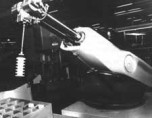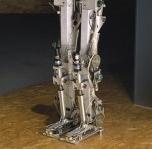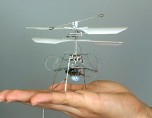Laws of robotics:-
Laws of Robotics are a
set of laws, rules, or principles, which are intended as a fundamental
framework to underpin the behavior of robots designed to have a degree of
autonomy. Robots of this degree of complexity do not yet exist, but they have
been widely anticipated in science fiction, films and are a topic of active
research and development in the fields of robotics and artificial intelligence.
Asimov’s Three Laws of Robotics:
The best known set of laws are Isaac Asimov's "Three Laws of
Robotics". These were introduced in his 1942 short story
"Runaround", although they were foreshadowed in a few earlier
stories.
1.
A robot may not injure a human being or, through inaction, allow a
human being to come to harm.
2.
A robot must obey any orders given to it by human beings, except
where such orders would conflict with the First Law.
3.
A robot must protect its own existence as long as such protection
does not conflict with the First or Second Law.
EPRSC / AHRC principles of robotics
In 2011, the Engineering and Physical Sciences
Research Council (EPRSC) and the Arts and Humanities Research
Council (AHRC) of Great Britain jointly published a set of five ethical "principles
for designers, builders and users of robots" in the real
world, along with seven "high-level messages"
intended to be conveyed, based on a September 2010 research
workshop.
*Robots should not be designed solely or primarily to kill
or harm humans.
*Humans, not robots, are responsible agents. Robots are
tools designed to achieve human goals.
*Robots should be designed in ways that assure their safety
and security.
*Robots are artifacts; they should not be designed to
exploit vulnerable users by evoking an emotional response or dependency. It
should always be possible to tell a robot from a human.
*It should always be possible to find out who is legally
responsible for a robot.
*The messages intended to be conveyed were:
*We believe robots have the potential to provide immense
positive impact to society. We want to encourage responsible robot research.
*Bad practice hurts us all.
*Addressing obvious public concerns will help us all make
progress.
*It is important to demonstrate that we, as roboticists, are
committed to the best possible standards of practice.
*To understand the context and consequences of our research,
we should work with experts from other disciplines, including: social sciences,
law, philosophy and the arts.
*We should consider the ethics of transparency: are there
limits to what should be openly available?
*When we see erroneous accounts in the press, we commit to
take the time to contact the reporting journalists.
AIonAI (artificial intelligence-on-artificial intelligence) Law:-
In 2013 Hutan Ashrafian at Imperial College London, proposed
an additional law that considered the role of artificial
intelligence-on-artificial intelligence or the relationship between robots
themselves – the so-called AIonAI law. This law states:
All robots endowed with comparable human reason and conscience
should act towards one another in a spirit of brotherhood.
Why Asimov's Three Laws Of Robotics Can't Protect Us:-
As late as 1981, Asimov himself believed that
they could actually work. Writing in Compute!, he noted that,
I have
my answer ready whenever someone asks me if I think that my Three Laws of
Robotics will actually be used to govern the behavior of robots, once they
become versatile and flexible enough to able to choose among different courses
of behavior. My answer is, "Yes, the Three Laws are the only way in which
rational human beings can deal with robots — or with anything else.
















 1. They can save lives. In natural and manmade disasters, UAS can be positioned to survey damage, locate stranded and injured victims, and assess ongoing threats without risking the safety of rescue teams and first-responders.
1. They can save lives. In natural and manmade disasters, UAS can be positioned to survey damage, locate stranded and injured victims, and assess ongoing threats without risking the safety of rescue teams and first-responders.
 3. They can contribute to safe infrastructure maintenance and management. Consider the difficulty of inspecting the underside of a bridge or the top of a skyscraper, not to mention the costs and risks. With UAS, scaffolding, cranes, or harnesses are not required. Just deploy the system to assess the structure's condition remotely.
3. They can contribute to safe infrastructure maintenance and management. Consider the difficulty of inspecting the underside of a bridge or the top of a skyscraper, not to mention the costs and risks. With UAS, scaffolding, cranes, or harnesses are not required. Just deploy the system to assess the structure's condition remotely. 4. They can streamline agriculture management. Using a crop management system to observe, measure, and respond to variability in individual plants, farmers can target areas requiring attention. By pinpointing these areas, farmers can provide care only where needed—improving yield, conserving resources, and avoiding waste.
4. They can streamline agriculture management. Using a crop management system to observe, measure, and respond to variability in individual plants, farmers can target areas requiring attention. By pinpointing these areas, farmers can provide care only where needed—improving yield, conserving resources, and avoiding waste. 5. They can give media access to hard-to-reach places. Aerial photography for a news broadcast or a blockbuster film can be efficiently, economically, and safely captured by a UAS.
5. They can give media access to hard-to-reach places. Aerial photography for a news broadcast or a blockbuster film can be efficiently, economically, and safely captured by a UAS.